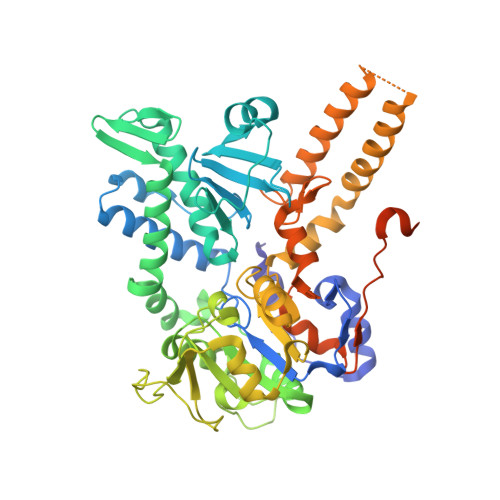Lead optimization and biological evaluation of fragment-based cN-II inhibitors.
Guillon, R., Rahimova, R., Egron, D., Rouanet, S., Dumontet, C., Aghajari, N., Jordheim, L.P., Chaloin, L., Peyrottes, S.(2019) Eur J Med Chem 168: 28-44
- PubMed: 30798051
- DOI: https://doi.org/10.1016/j.ejmech.2019.02.040
- Primary Citation of Related Structures:
6FIR, 6FIS, 6FIU, 6FIW, 6FXH - PubMed Abstract:
The development of cytosolic 5'-nucleotidase II (cN-II) inhibitors is essential to validate cN-II as a potential target for the reversion of resistance to cytotoxic nucleoside analogues. We previously reported a fragment-based approach combined with molecular modelling, herein, the selected hit-fragments were used again in another computational approach based on the Ilib-diverse (a software enabling to build virtual molecule libraries through fragment based de novo design) program to generate a focused library of potential inhibitors. A molecular scaffold related to a previously identified compound was selected and led to a novel series of compounds. Ten out of nineteen derivatives showed 50-75% inhibition on the purified recombinant protein at 200?¦ÌM and among them three derivatives (12, 13 and 18) exhibited K i in the sub-millimolar range (0.84, 2.4 and 0.58?mM, respectively). Despite their only modest potency, the cN-II inhibitors showed synergistic effects when used in combination with cytotoxic purine nucleoside analogues on cancer cells. Therefore, these derivatives represent a family of non-nucleos(t)idic cN-II inhibitors with potential usefulness to overcome cancer drug resistance especially in hematological malignancies in which cN-II activity has been described as an important parameter.
Organizational Affiliation:
Institut des Biomol¨¦cules Max Mousseron (IBMM), UMR 5247 CNRS, Universit¨¦ de Montpellier, ENSCM, Campus Triolet, cc1705, Place Eug¨¨ne Bataillon, 34095, Montpellier, France.

















